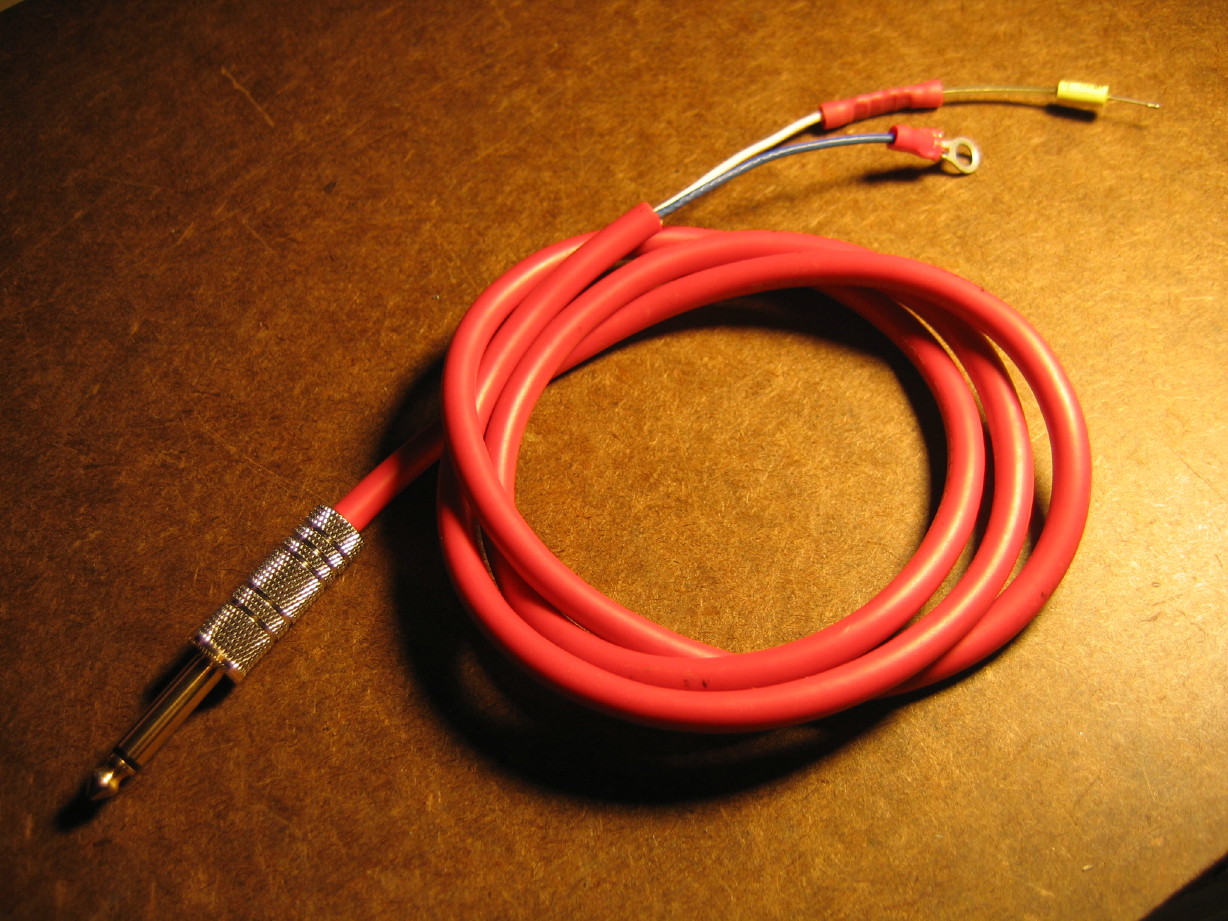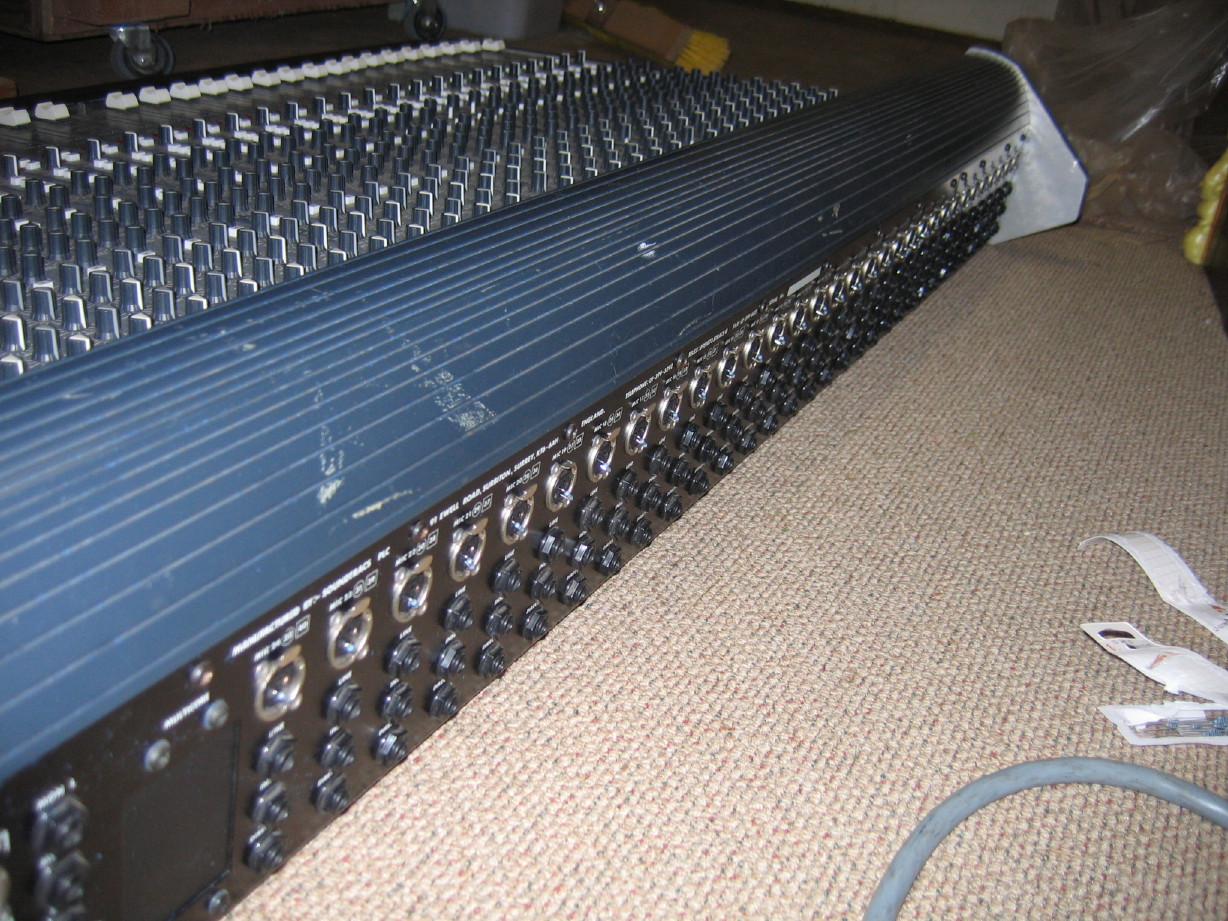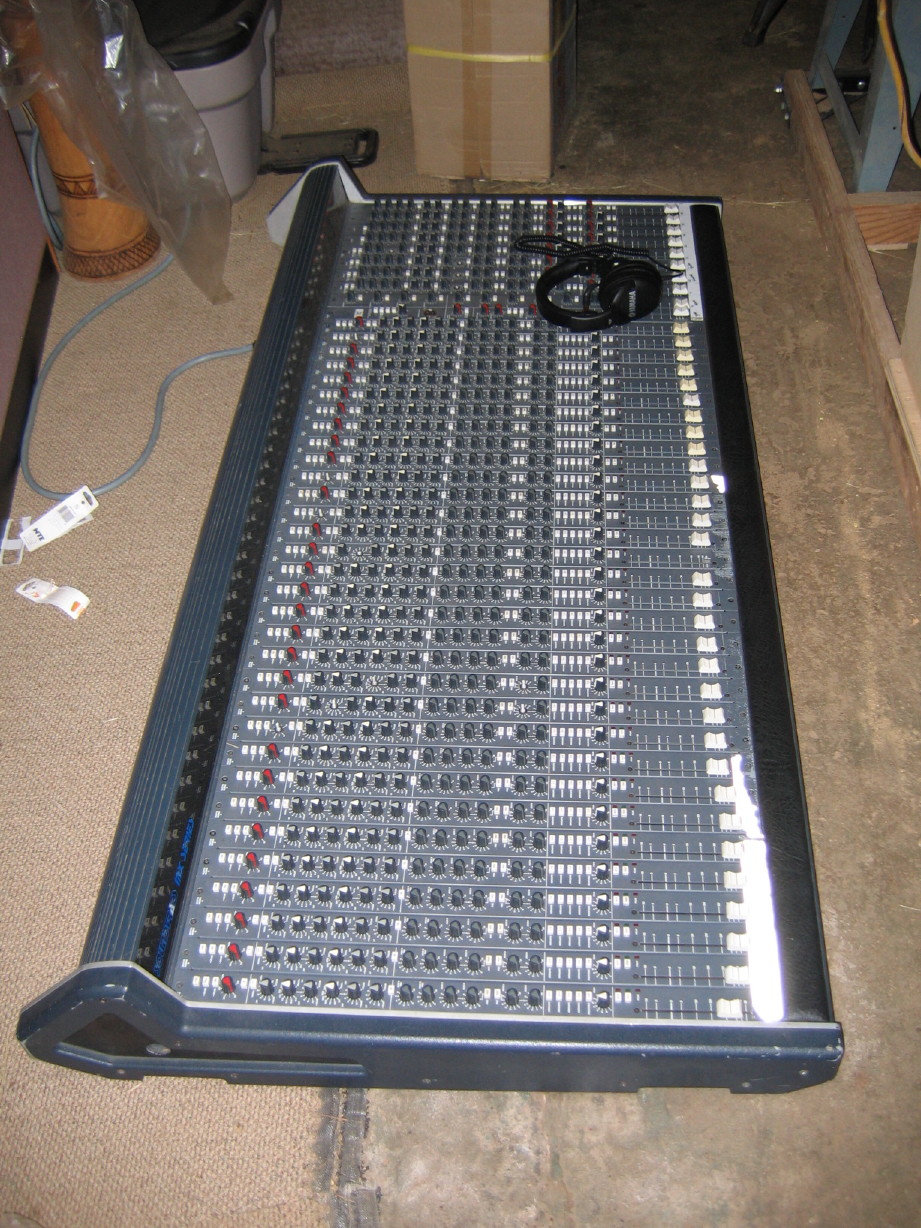sweetbeats
Reel deep thoughts...
You'll find the beginnings of this story in this thread in post #45.
Have a seat, pour a hot cup or crack a cold one or whatever your preference and read on to my longest single post ever...
Background...
A bunch of you know the background already, but for those who aren't regulars around here I give you this background blurb. I have a mixer already...actually I guess I have 3 mixers:
So I wasn't looking for a mixer, really, and on top of that I'm actively trying to simplify and reduce too. So why go pick up this relative behemoth??
The Yamaha is digital and I figured out long ago that, for me, I prefer an analog mixer so the Yamaha isn't really part of the consideration. The Yamaha has never disappointed me. It is one of my best purchases ever. I have the i88x as well as a Presonus Digimax FS. The trio make a compact but powerful system in terms of I/O options and the 01X serves as a wonderful control surface for my DAW software which is Cubase. So I'm just totally set in the digital department and I actually kind of like that all three of those units are discontinued. BUT, that's digital, and I like working with audio in analog. So that's what originally got me into the pursuit of an analog mixer which initially was my Tascam M-520 which I sold last year in favor of the M-__.
BUT, that's digital, and I like working with audio in analog. So that's what originally got me into the pursuit of an analog mixer which initially was my Tascam M-520 which I sold last year in favor of the M-__.
The 388 has a great compact 8 x 8 analog mixer but it is heavily geared toward serving the tape section of the 388...no qualms there...makes perfect sense but it bears mentioning that Tascam did a very fine job of including features that allow the mixing section to standalone as well. They didn't have to do that but they did. In spite of that the 388 mixer is not up to snuff feature-wise with what I need to serve as a hub for my hybrid analog and digital "studio".
Then there's the M-__. There have been niggling thoughts in the back of my mind ever since I got the M-__ whether or not it had the capacity to be IT for me as far as a mixer. It was clearly an emotional decision that led me to drive well over 2000 miles to get it, and it was emotion that caused me to decide to keep it rather than the M-520, even though the M-520 has 40% more channel capacity. "How could I NOT keep the M-__ when its so stinkin' cool and rare!" thought I. So those niggling thoughts been aptly shoved into the back of my mind with a trumping "Aw I'll make it work" blanket. Well, its been getting harder and harder, and especially so since I've used it in a tracking situation and since I got my Ampex MM-1000. The M-__ is nauseatingly flexible and its power is in its inline features. Each of the 12 strips has 3 main input paths, and has a total of 5 if you count the auxilliary insert return jack and the BUSS IN jack...insane. And you can easily source and monitor the 3 main inputs at once. This would certainly seem to make it effective for an 8-track machine as well as a smaller DAW system. Pretty much just right. What was hanging in the back of my mind was what I would have to do for larger DAW projects. I typically like about 16 channels to work with, and some digital projects have been in the 24-track range. With the rarity and features of the M-__ I had resigned myself to just physically patch where and when necessary and group "in-the-box" as needed. The other main niggling thought was in the area of aux sends...the M-__ has 4. Its nice, even in my little home setup, to have the capability to dial up two cue mixes...and I've found that it is really helpful to be able to run at least one of them in stereo...the dry mix in mono with a stereo reverb. Mind you this is from experience now rather than idealistic daydreams (which I do A LOT of). Well, that would use 3 sends. I have a total of 5 effects units I like to use:
So, you see, 4 aux sends gets tight...no, I don't use all those effects at once and not all the stereo engines are always run stereo (the Quadraverb, for instance, kicks out some AWESOME digital feedback on some of the mono delay patches and that's what I usually like to use it for), and rarely do I run both engines of the 01X and typically one stereo and one mono. But a typical scenario would be using 4~5 aux channels for effects which, at best, leaves no room for cue mixes.
ANOTHER niggling thought that has been stuffed away under the emotionally driven lie that "I can fix anything" is the fact that the M-__ is a prototype board. Everything seems to function though its got some issues that may be just because its older, or may be something else. With help I've surmounted some daunting (for me) challenges with that thing, but here's the rub: my whole inital dream was to have a space with gear I like to use and with which I'm familar setup, ready to go at a moment's notice so I can go in, hit the power switch and be ready to track in just minutes. That was the dream. I've been really, really good over the years at making do with what space I had (which never seemed to get larger than about 6' x 7.5'...and that was to include the drumkit too ), and with a very limited budget within which I resorted to learning how to fix stuff so I could get better gear for less money because it was a fixer-upper. Well, the M-__ has been kind of the ultimate fixer-upper because there is no documentation on it, and I haven't found anybody that knows anything about it. I am, apparently, the world's expert on the M-__. I'm sure that somewhere there is somebody that knows more about it, but they remain unknown. So the issue is that if something goes wrong with the M-__ there will never be a parts unit to draw from, or an expert source to utilize for troubleshooting. You folks are all just awesome help, but I know me...I will always want to be able to do it all...I will always want it to function 100%. I dislike having to bug Ethan everytime something goes sideways that is beyond my technical scope. I don't like taking all the time and I haven't much to offer in-kind to somebody like Ethan, for instance. He has always said "no sweat/bring it by/send me the info" etc. But at some point I don't want to be dependent on that kind of help because it doesn't work when you're in the middle of a session whether professional or recreational to try and track that down. Do you see what I'm saying? Sure, there is NO PIECE OF GEAR that will work 100% of the time for all time. I'm realistic in that, but there's no fall-back with the M-__...no spare channel strip to drop in, no schematic to refer to to expedite the fix or at least to widen the pool of support (YOU try getting people interested in helping you when all you can say is "I've got [wierd issue 'X'] on this one-of-a-kind piece of gear and I've got no documentation on it...can you help???")...
), and with a very limited budget within which I resorted to learning how to fix stuff so I could get better gear for less money because it was a fixer-upper. Well, the M-__ has been kind of the ultimate fixer-upper because there is no documentation on it, and I haven't found anybody that knows anything about it. I am, apparently, the world's expert on the M-__. I'm sure that somewhere there is somebody that knows more about it, but they remain unknown. So the issue is that if something goes wrong with the M-__ there will never be a parts unit to draw from, or an expert source to utilize for troubleshooting. You folks are all just awesome help, but I know me...I will always want to be able to do it all...I will always want it to function 100%. I dislike having to bug Ethan everytime something goes sideways that is beyond my technical scope. I don't like taking all the time and I haven't much to offer in-kind to somebody like Ethan, for instance. He has always said "no sweat/bring it by/send me the info" etc. But at some point I don't want to be dependent on that kind of help because it doesn't work when you're in the middle of a session whether professional or recreational to try and track that down. Do you see what I'm saying? Sure, there is NO PIECE OF GEAR that will work 100% of the time for all time. I'm realistic in that, but there's no fall-back with the M-__...no spare channel strip to drop in, no schematic to refer to to expedite the fix or at least to widen the pool of support (YOU try getting people interested in helping you when all you can say is "I've got [wierd issue 'X'] on this one-of-a-kind piece of gear and I've got no documentation on it...can you help???")...
The nail in the coffin has been the MM-1000 which I may run as a 16-track someday...I have 95% of what's needed for the conversion. That just won't work on a 12 x 8 mixer. I can DO it on the M-__ but it would be way kludgey and I'd be taking time to creatively patch when interfacing the M-__ with the MM-1000. I'm tired of having to be so creative and resourceful on the technical side. After hearing audio through the MM-1000 recently the whole original dream woke up again and I'm anxious to get back to making music and having fun. That calls for a more straight-forward setup with more channels, and we are just about to secure permits on some changes to our home that will include a 10' x 11' sound-proof room...bigger space...tired of making do...
So all those niggling thoughts were getting louder and louder and then I saw this on craigslist:
.jpg)
That's relatively local to me. It aroused my curiosity so I started looking into Soundtracs because I'd never heard of them before, or at least never noticed.
The Soundtracs M-series...
Soundtracs is a British company that is still alive under the name DigiCo...maker of very fine digital consoles. There is still active support on my side of the pond as well as over in the UK.
Hm...
After a bit I determined that the desk on craigslist was an MX series mixer from the late 80's...brochure here...
The MX was designed for live FOH applications. There is a recording version called the MRX, and there is also the MCX which was for monitor applications. The main differences between the MX and the MRX are that the group section on the MRX features a 16-track monitor facility and there were in-frame TT patchbay options. By contrast the MX has an 8-track monitor facility (each labeled as "RETURN") as opposed to 16-track, and no patchbay options, but the MX features an 8 x 4 matrix on the 8 groups which is lacking on the MRX.
I thought "oooo an MRX would be awesome" but they are, I understand, VERY hard to find. So I kept in communication with the seller, asking questions of the mixer's history, why he's selling it, all that stuff. Everything I read told me that the M-series mixers are good sounding desks that are well-made...even gear snobs seemed to be saying things like "the pre's aren't bad" or "I wouldn't be embarrased to use the onboard pre's", that sort of thing, which may not sound great but these are people that swear by $2000 outboard pre's and say things like "sound like ass" when discussing our beloved Tascam pre's. My point is that I figured I wouldn't be unsatisfied with the pre's in the Soundtracs. And folks referred to the "true British eq" FWIW. So anyway there wasn't anything scaring me away. And then I got some more detail in that the mic pre's feature a discrete circuit which now gets my attention after my experience with my Ampex tape deck electronics, and that the desk has 22dB's of headroom...mmmmm...dang. THEN I start digging into specifics on the features...separate MIC and LINE inputs with a source switch on the control surface...balanced line inputs no less...direct out and insert jacks...phantom, phase reverse and pad too. 4-band eq with mid sweeps and a bypass switch, 6 aux sends very configurable by strip pre/post fader and pre/post eq in pairs via switches and jumper settings and then of course the assign section. Typical mute and solo functions. Nice straight ahead mixer strip...everything I'd like but not too much. Over in the master section there is a usable oscillator and talkback circuit, separate monitor out with level, mono and dim switches with some switchable sourcing, routable 2-track return...master controls for the matrix and aux sends with AFL circuits...again, enough but too much...very useful. The group section is powerful...there are the 8 returns I mentioned and those can be dumped to the main buss or to the group channels so lots of flexibility there, and there is a 2-band fixed eq too that can be applied to the returns OR the group channels. Very handy. And then sends on the groups...the groups also have all 6 aux sends on them with pre/post sourcing control switches and they can source from the returns or the group channels...AND there is an 8 x 4 matrix on the groups that are switcheable pre/post group fader so that basically gives you 10 sends on the group channels, and of course the groups can be routed individually to the main buss or to group out jacks...lots of usable flexibility there...the matrix could be used as cue feeds or effects sends. Just a handy feature set. There are 11 10-segment LED meters for the main and solo busses and then the 8 group meters are switcheable to also cover the matrix outs and aux sends. The input meters for each of the input strips were optional. That would be neat, but really I'm not sure how useful that would be. Peak LED's on the strips light at 5dB's below clipping and in my experience that is more critical to have a handle on that, especially when I have analog VU's on the Ampex for monitoring levels to and from tape...might be nice to have meters on the tape return strips on the desk but if I calibrate the input trims on the desk to coincide with the output levels on the MM-1000 I should just be able to refer to the meters on the Ampex...
My point is that I figured I wouldn't be unsatisfied with the pre's in the Soundtracs. And folks referred to the "true British eq" FWIW. So anyway there wasn't anything scaring me away. And then I got some more detail in that the mic pre's feature a discrete circuit which now gets my attention after my experience with my Ampex tape deck electronics, and that the desk has 22dB's of headroom...mmmmm...dang. THEN I start digging into specifics on the features...separate MIC and LINE inputs with a source switch on the control surface...balanced line inputs no less...direct out and insert jacks...phantom, phase reverse and pad too. 4-band eq with mid sweeps and a bypass switch, 6 aux sends very configurable by strip pre/post fader and pre/post eq in pairs via switches and jumper settings and then of course the assign section. Typical mute and solo functions. Nice straight ahead mixer strip...everything I'd like but not too much. Over in the master section there is a usable oscillator and talkback circuit, separate monitor out with level, mono and dim switches with some switchable sourcing, routable 2-track return...master controls for the matrix and aux sends with AFL circuits...again, enough but too much...very useful. The group section is powerful...there are the 8 returns I mentioned and those can be dumped to the main buss or to the group channels so lots of flexibility there, and there is a 2-band fixed eq too that can be applied to the returns OR the group channels. Very handy. And then sends on the groups...the groups also have all 6 aux sends on them with pre/post sourcing control switches and they can source from the returns or the group channels...AND there is an 8 x 4 matrix on the groups that are switcheable pre/post group fader so that basically gives you 10 sends on the group channels, and of course the groups can be routed individually to the main buss or to group out jacks...lots of usable flexibility there...the matrix could be used as cue feeds or effects sends. Just a handy feature set. There are 11 10-segment LED meters for the main and solo busses and then the 8 group meters are switcheable to also cover the matrix outs and aux sends. The input meters for each of the input strips were optional. That would be neat, but really I'm not sure how useful that would be. Peak LED's on the strips light at 5dB's below clipping and in my experience that is more critical to have a handle on that, especially when I have analog VU's on the Ampex for monitoring levels to and from tape...might be nice to have meters on the tape return strips on the desk but if I calibrate the input trims on the desk to coincide with the output levels on the MM-1000 I should just be able to refer to the meters on the Ampex...
I started thinking about the MX vs. the MRX and just analyzing my needs overall but I started seeing the MX as a 16 x 16 x 8 x 2 desk rather than a 32 x 8 x 2. I don't have more than 16 sources in my home studio, so those could be hooked up all the time to dedicated strips, and then the second bank of 16 strips could be dedicated tape returns ready for a 2" 16-track if the MM-1000 gets to that point. That left all the sends and returns available in the group section for effects sends and returns. "Wow" I started thinking...everything permanently hooked up ready to go...I started to get concerned that there was no dedicated monitor mix, but with 6 aux sends one of those could be a mono monitor mix easily sourceable via the AFL circuit. I think the matrix sends might just work for effects sends in just about every situation...they can source the group or the return, and the aux sends in the group master section can source the returns or the group. This would cover being able to return wet mixes to cue feeds (via aux sends) or print wet to tape during multi-tracking or print wet to tape during mastering. Okay, so I'm thinking "this could work out really well." Then I started looking at the under-the-hood aspects.
I already talked about the headroom and the mic pre circuit, but summing is via one of my favorite opamps, the 5532. Steven Magalnick writes that he has done lots of experimentation with opamp upgrades on the M-series boards and the clients have always opted to switch back to stock because it sounded best...that it had quality and character in stock trim and something got lost with the upgrade. All the PCB's are thick good quality glass fiber, even the jack PCB's...and all the jacks are affixed to steel paneling. All the channel strips come out with 2 screws and then you disconnect two connectors, one of which is affixed with lock tabs so it comes apart in a quick-release fashion and being interconnected via connectors rather than a plugin module to a motherboard means no long-term issues with the motherboard. Screwdriver in hand I can literally pull a channel strip out in about 20 seconds. IC's are socketed throughout. The group, main, matrix and aux sends are all on XLR jacks. In stock trim the M-series mixer outputs are unbalanced, but there is a balancing transformer option for those XLR outs...the cable harnessing is there and I have the tech document on it so if I decide to balance the outputs its a matter of selecting and purchasing the trannies and wiring them up. And there is an intriguing "Multicore" blank panel at the back which I'm assuming is for setting up a snake interconnect on a multipin cable like an ELCO connector rather than having to use the jacks. Then the frame itself is very nicely designed and built...very substantial cross-members, and thick end-plates with sturdy decorative end-caps with built-in handles, and the shape of the end plates feature rearward protrusions which serve as legs so if you need to tip the mixer on its back to access the innards from the bottom you can do so without unplugging anything. Just all very nice and smart.
MY mixer...
I was told at $500 it was a good deal for such a mixer, and I made the decision to pursue it.
The trick is that I didn't NEED it necessarily, so I was very honest with the seller and just told him where I was at in terms of need and made a low-ball offer of $250 and I'd come and get it. He countered at $300 and he'd bring it 80% of the way to which I answered bring it on and let's have a look. He had been trying to sell it for about 3 months, was in between jobs and just needed to get it gone. Plus I don't think he really understood what he had. Case in point, he listed it as 24 mono and 8 stereo, but it is actually 32 mono strips. I'd think it would have been marketed better had he understood what it was. Maybe that's just me wanting to feel good about what I got.
I'd think it would have been marketed better had he understood what it was. Maybe that's just me wanting to feel good about what I got. 
I had pretty much figured that if it was all there when I met with the seller I'd take it. It was, and I (obviously) did.
The history on this particular mixer is that it was purchased new by a high school and used in their auditorium until a number of years ago. The seller had been involved in the audio department and after graduating participated in engineering for a 2 month production put on by the school. The school had already upgraded their sound system so the Soundtracs was out of service at that point. The school couldn't pay the guy for his service so they gave him the mixer at the end of the production as a form of payment. The seller had ideations of starting a studio but it never got off the ground and he is partial to the conveniences of digital gear; "the Soundtracs is just so big"...so the MX has been in storage most the time since he took possession, most of which was in a very arid part of the state which is good. It shows some battle scars...scuffs and scratches but no oxidation and the control surface is quite unscathed except for 6 busted pot shafts and a smattering of missing knobs...the pot shafts are (I think) ceramic so more brittle than plastic or metal. I've got a source on some spare channel strips which is probably what I'll do to source replacement pots and knobs. Otherwise, outside of needing a good cleaning its all there and functional. Haven't gone through every feature yet but basic testing demonstrates I bought a working mixer for once.
5' 6" wide and a svelte 136lbs.
It hit me the day before I picked it up...I'm about 5' 7" tall. I was measuring some space and furniture in the event that the mammoth came to live here. I put the measuring tape vertically from the floor and realized that the mixer was big enough that if stood on end I would be looking up at the opposing end (since my eyes are not at the very top of my towering 5' 7" stature )
)
Well, in usual sweetbeats form, on to some pictures. These I took before I unloaded it.
Overview shots of the mixer:
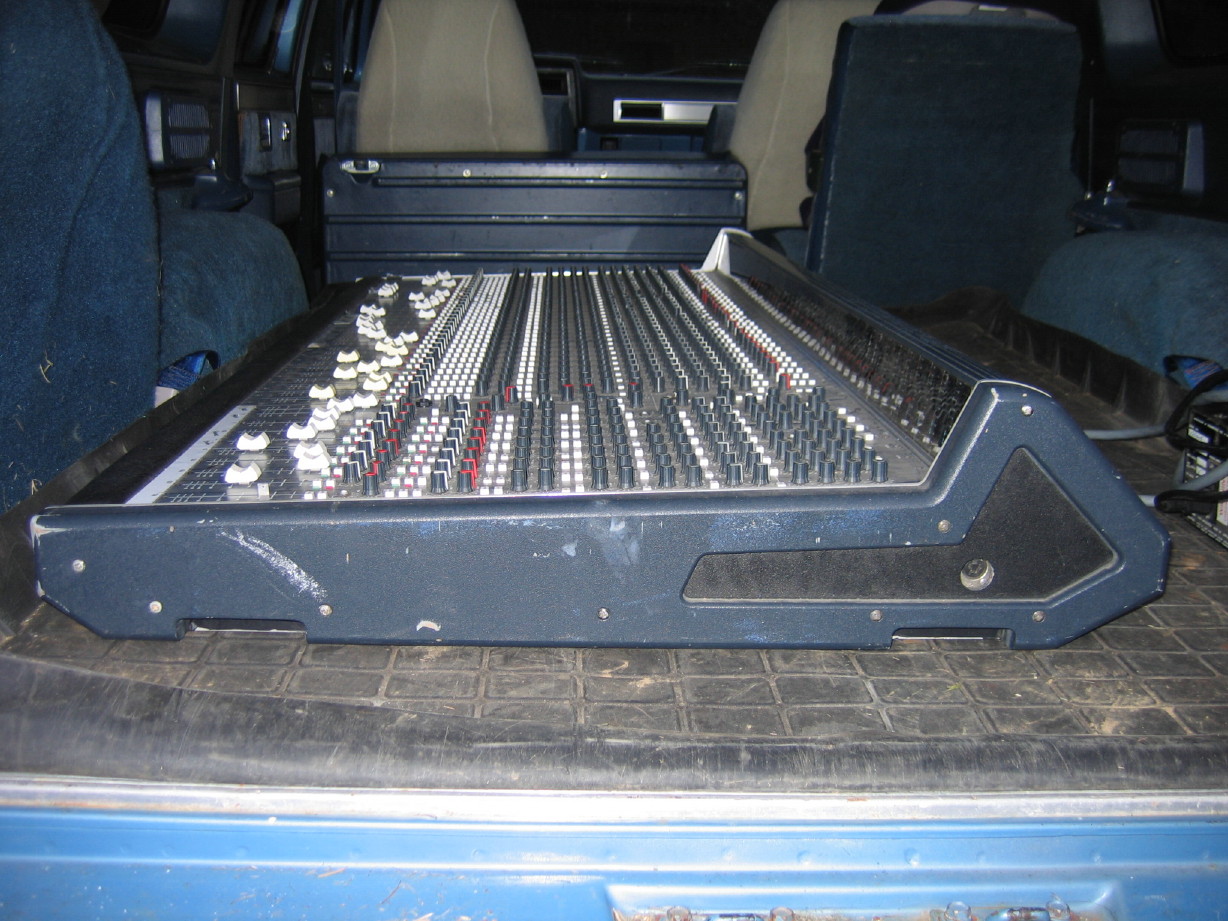
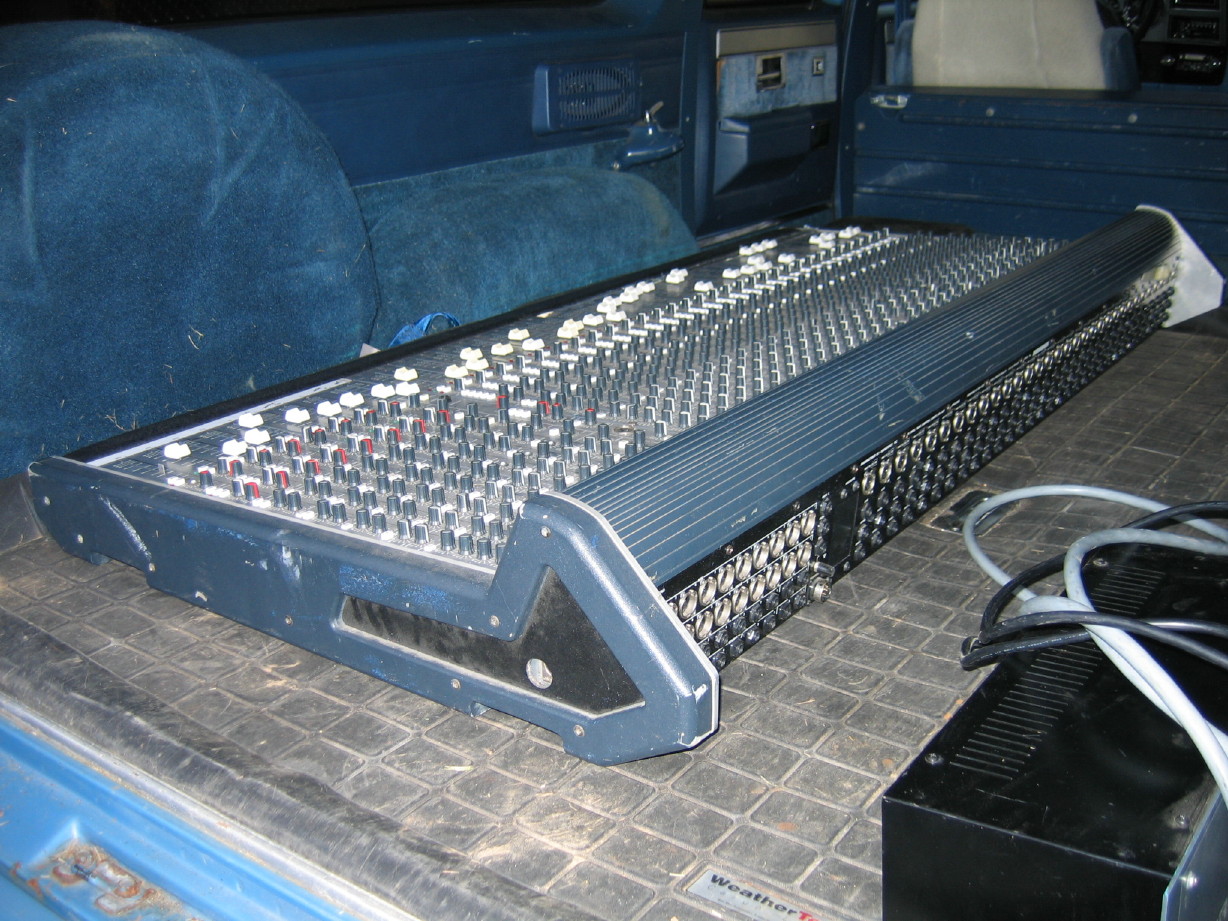
The master meter section and jack plate:
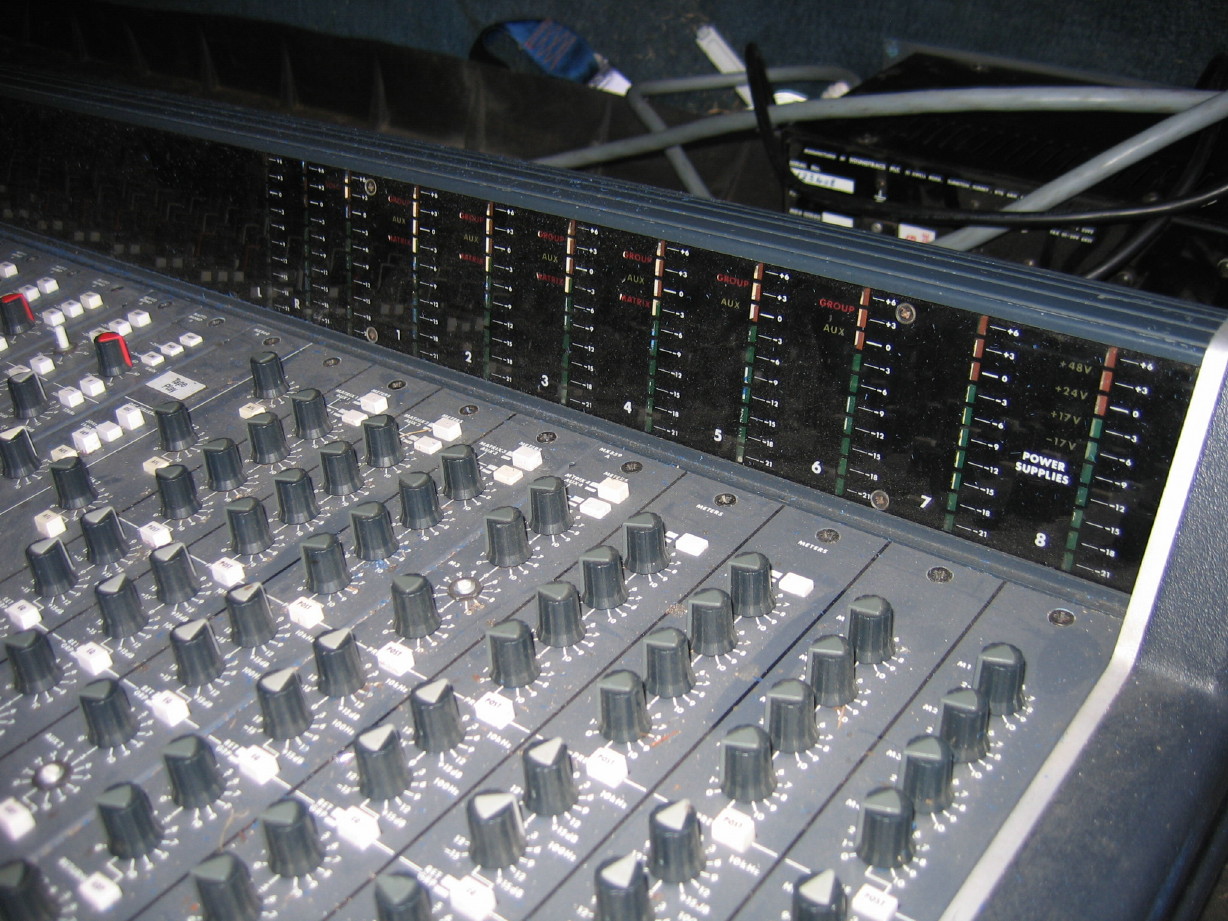
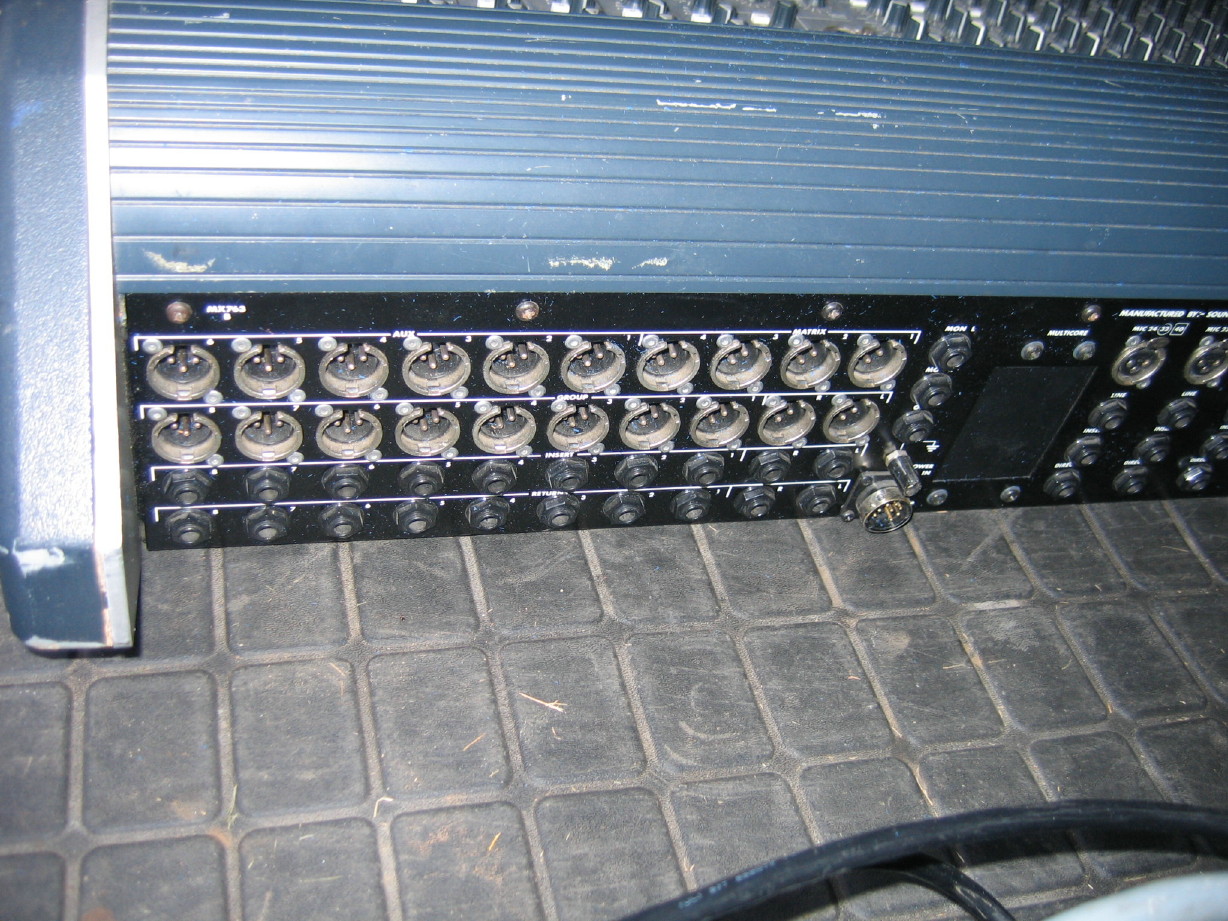
Fun low-light shots:
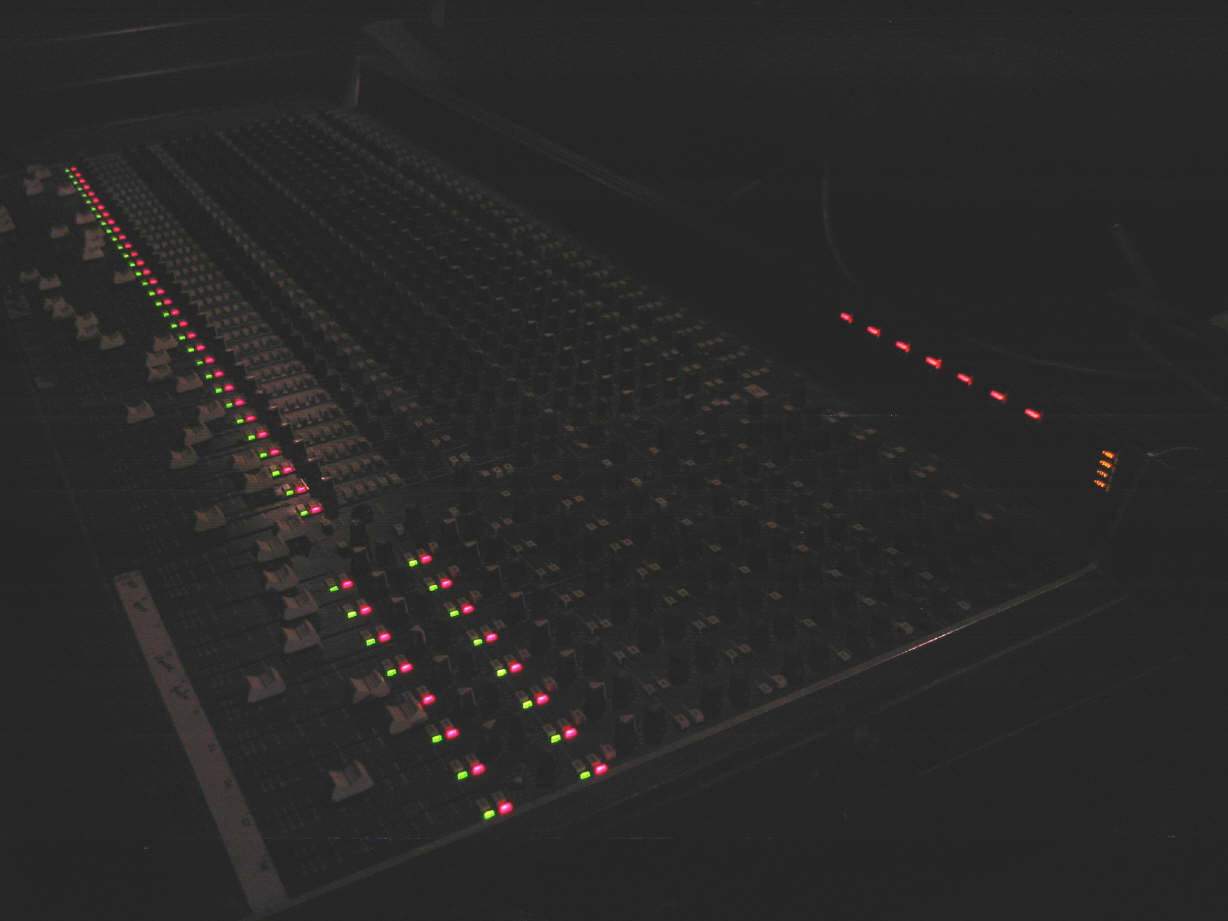
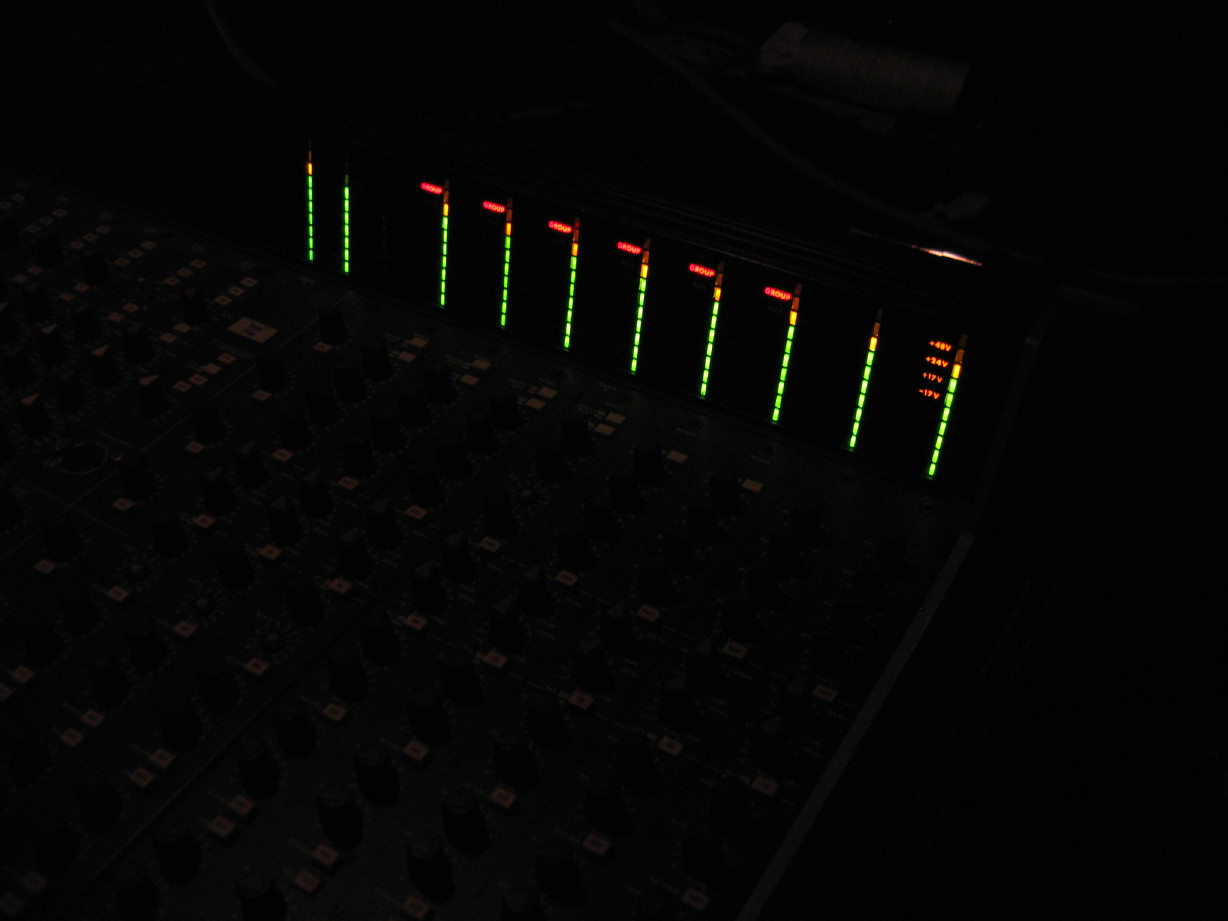
A channel strip:
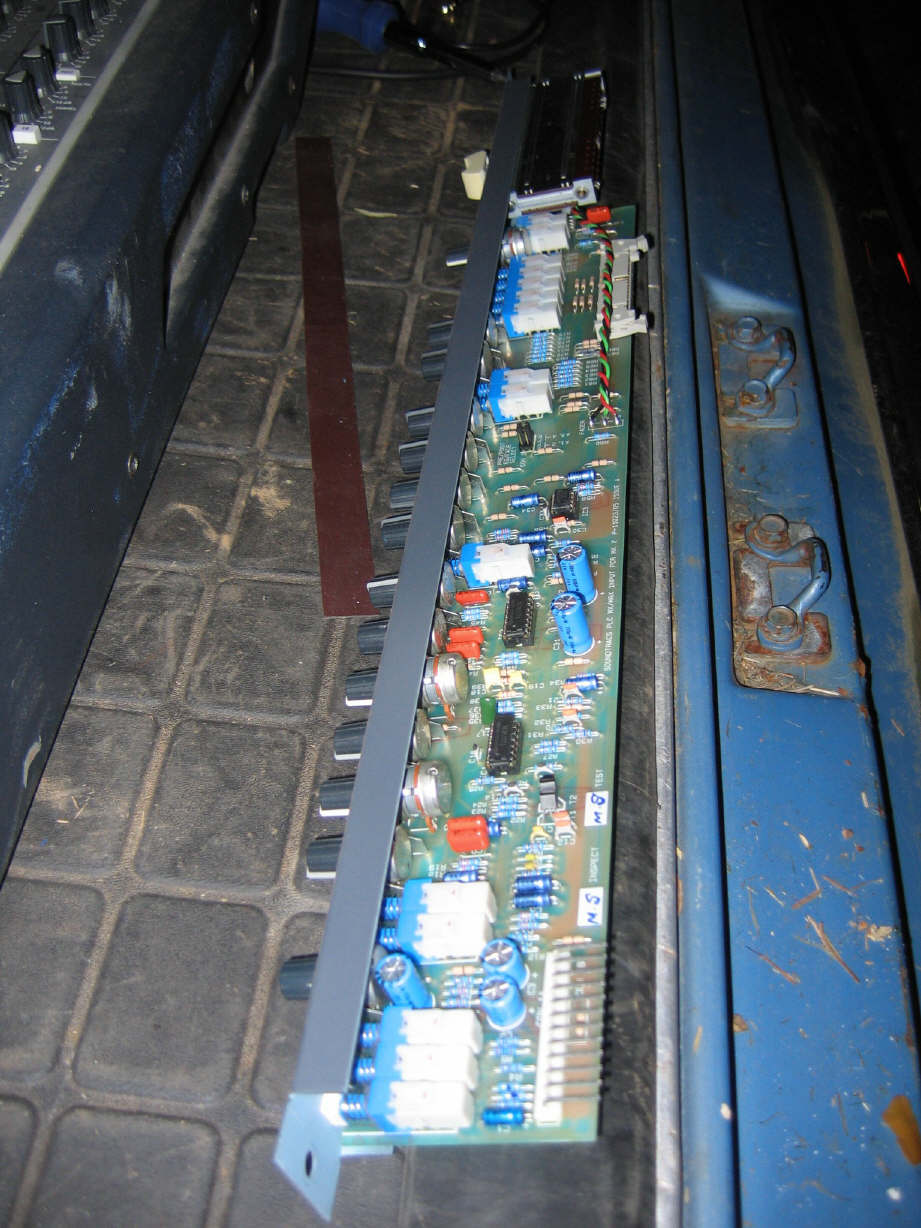
Annnd the power supply:
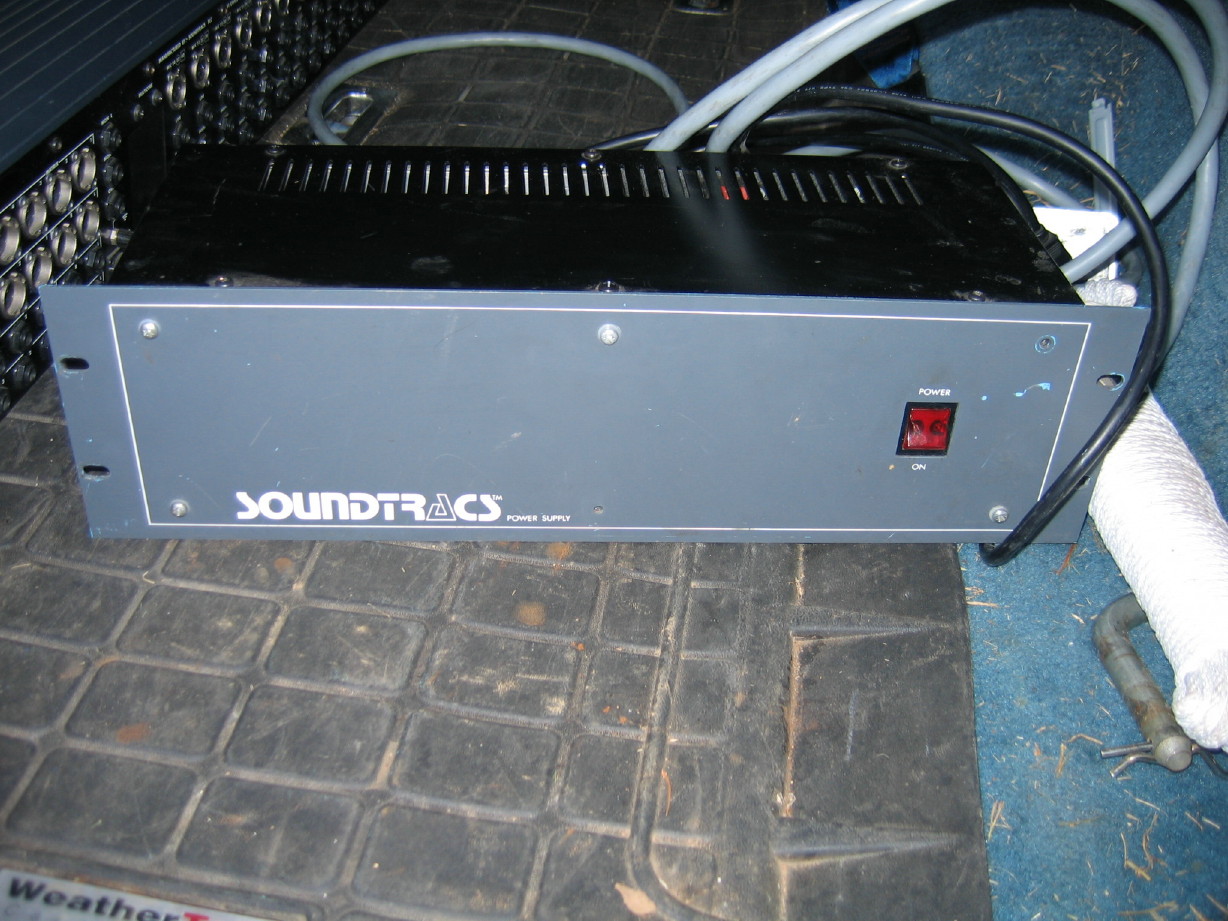
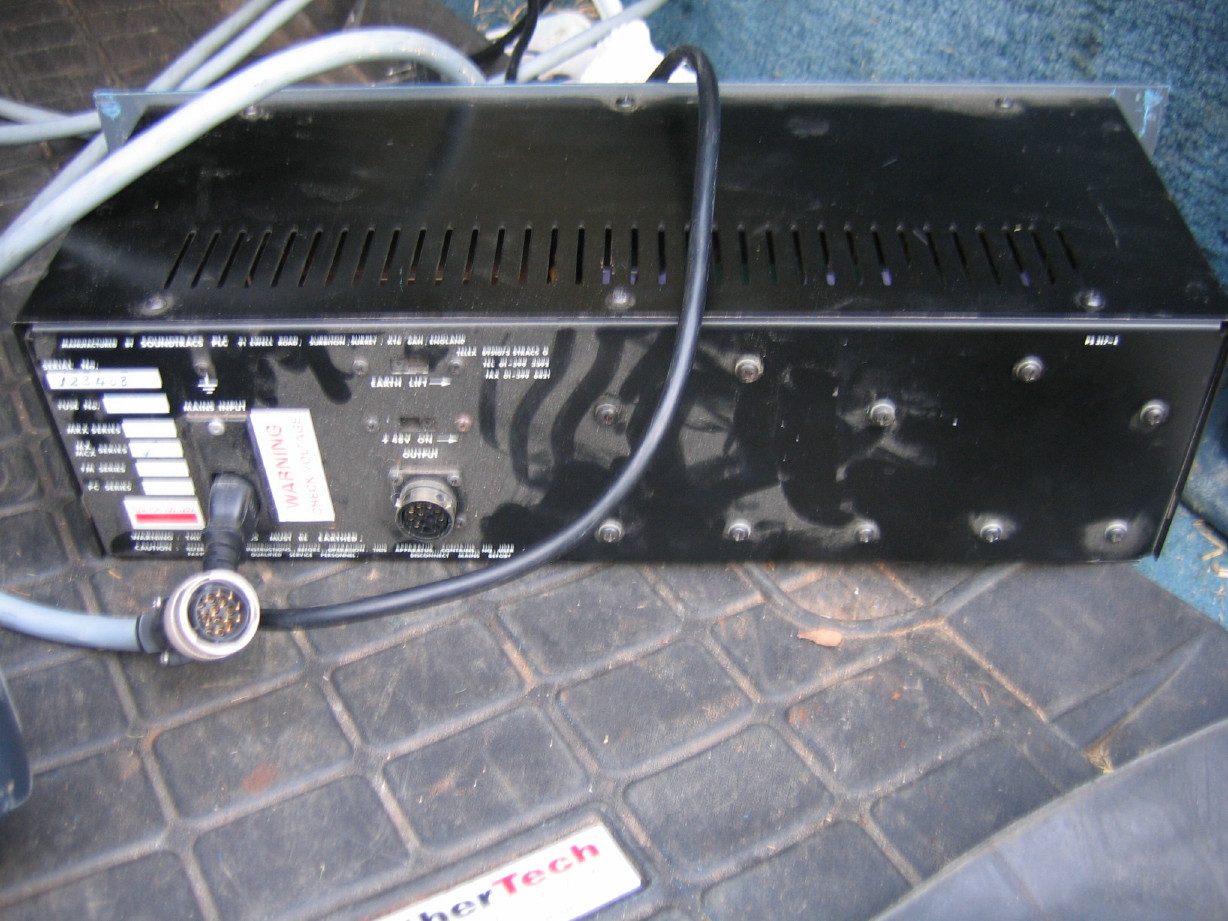
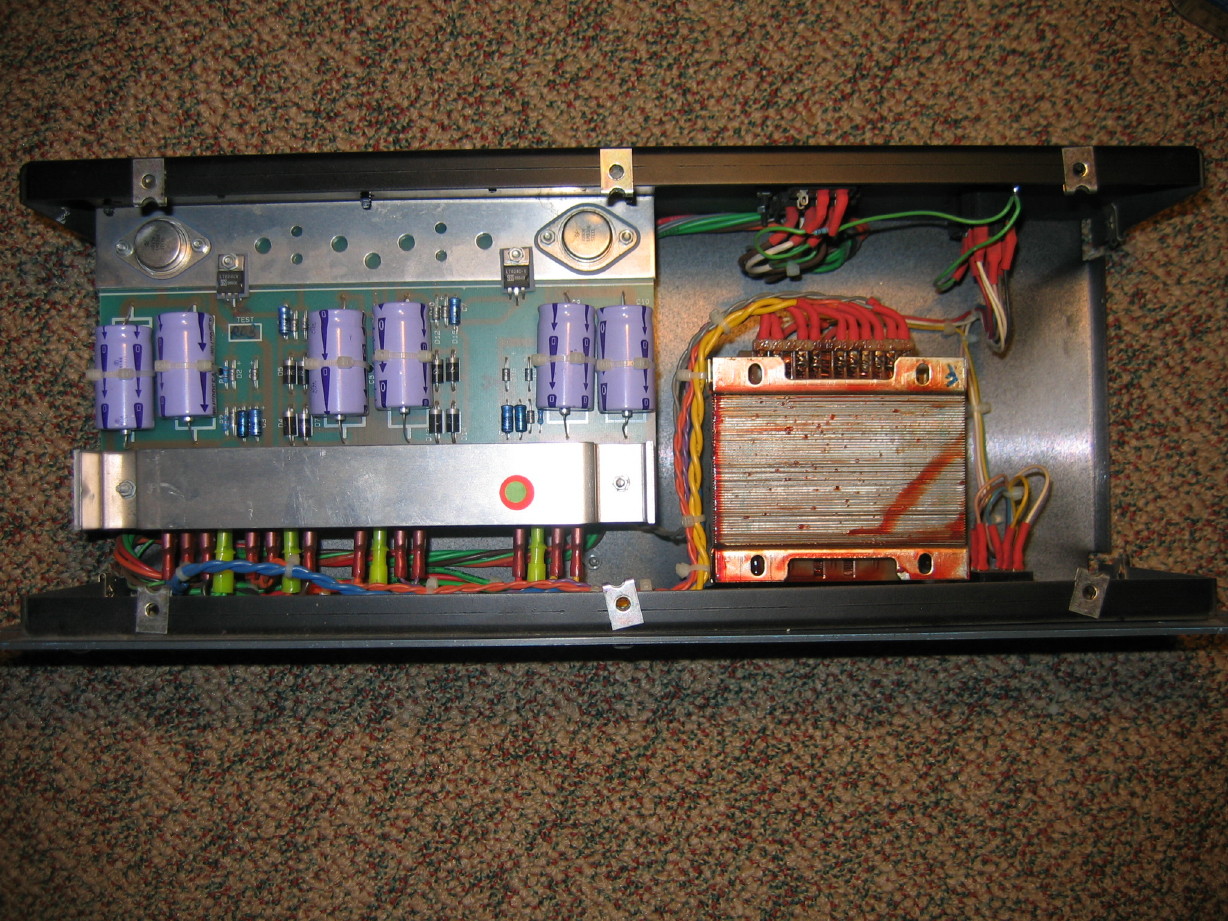
So for now the desk is safely tucked away in the shop until construction is complete. It is accessible so I will probably be pecking away at repairs here and there once I have spares here. Not going overboard on this one...just fix what's obvious and clean it up nice. The exception to this would be the power supply. I'm getting some paid support for instructions on some field tested upgrades to the power supply to increase relaibility and also to lower the noise floor in the PSU which has been measured to also lower the noise floor in the mixer by 6~12dB's. That's significant and IMO worth the expense since noise can stack up quick in a 32 channel mixer. Part of this will be a recap of the PSU too which I feel is cheap insurance for something that is nearly 25 years old. There are only 12 caps in the supply and since it will be opened up for the mods it'll be easy pickin's.
BTW, the PSU has already received a sweetbeats cleaning.
Stay tuned!
Have a seat, pour a hot cup or crack a cold one or whatever your preference and read on to my longest single post ever...
Background...
A bunch of you know the background already, but for those who aren't regulars around here I give you this background blurb. I have a mixer already...actually I guess I have 3 mixers:
- My Yamaha 01X
- My Tascam 388 (8 x 8 mixer with a lovely 1/4" 8-track open reel partner)
- My prototype Tascam modular inline 12 x 8 mixer from the early 80's
So I wasn't looking for a mixer, really, and on top of that I'm actively trying to simplify and reduce too. So why go pick up this relative behemoth??
The Yamaha is digital and I figured out long ago that, for me, I prefer an analog mixer so the Yamaha isn't really part of the consideration. The Yamaha has never disappointed me. It is one of my best purchases ever. I have the i88x as well as a Presonus Digimax FS. The trio make a compact but powerful system in terms of I/O options and the 01X serves as a wonderful control surface for my DAW software which is Cubase. So I'm just totally set in the digital department and I actually kind of like that all three of those units are discontinued.
 BUT, that's digital, and I like working with audio in analog. So that's what originally got me into the pursuit of an analog mixer which initially was my Tascam M-520 which I sold last year in favor of the M-__.
BUT, that's digital, and I like working with audio in analog. So that's what originally got me into the pursuit of an analog mixer which initially was my Tascam M-520 which I sold last year in favor of the M-__.The 388 has a great compact 8 x 8 analog mixer but it is heavily geared toward serving the tape section of the 388...no qualms there...makes perfect sense but it bears mentioning that Tascam did a very fine job of including features that allow the mixing section to standalone as well. They didn't have to do that but they did. In spite of that the 388 mixer is not up to snuff feature-wise with what I need to serve as a hub for my hybrid analog and digital "studio".
Then there's the M-__. There have been niggling thoughts in the back of my mind ever since I got the M-__ whether or not it had the capacity to be IT for me as far as a mixer. It was clearly an emotional decision that led me to drive well over 2000 miles to get it, and it was emotion that caused me to decide to keep it rather than the M-520, even though the M-520 has 40% more channel capacity. "How could I NOT keep the M-__ when its so stinkin' cool and rare!" thought I. So those niggling thoughts been aptly shoved into the back of my mind with a trumping "Aw I'll make it work" blanket. Well, its been getting harder and harder, and especially so since I've used it in a tracking situation and since I got my Ampex MM-1000. The M-__ is nauseatingly flexible and its power is in its inline features. Each of the 12 strips has 3 main input paths, and has a total of 5 if you count the auxilliary insert return jack and the BUSS IN jack...insane. And you can easily source and monitor the 3 main inputs at once. This would certainly seem to make it effective for an 8-track machine as well as a smaller DAW system. Pretty much just right. What was hanging in the back of my mind was what I would have to do for larger DAW projects. I typically like about 16 channels to work with, and some digital projects have been in the 24-track range. With the rarity and features of the M-__ I had resigned myself to just physically patch where and when necessary and group "in-the-box" as needed. The other main niggling thought was in the area of aux sends...the M-__ has 4. Its nice, even in my little home setup, to have the capability to dial up two cue mixes...and I've found that it is really helpful to be able to run at least one of them in stereo...the dry mix in mono with a stereo reverb. Mind you this is from experience now rather than idealistic daydreams (which I do A LOT of). Well, that would use 3 sends. I have a total of 5 effects units I like to use:
- Two stereo engines in the 01X
- An old Alesis Quadraverb (which is also stereo capable)
- A Tascam RS-20B stereo spring reverb
- A Roland DC-30 analog chorus/echo
So, you see, 4 aux sends gets tight...no, I don't use all those effects at once and not all the stereo engines are always run stereo (the Quadraverb, for instance, kicks out some AWESOME digital feedback on some of the mono delay patches and that's what I usually like to use it for), and rarely do I run both engines of the 01X and typically one stereo and one mono. But a typical scenario would be using 4~5 aux channels for effects which, at best, leaves no room for cue mixes.
ANOTHER niggling thought that has been stuffed away under the emotionally driven lie that "I can fix anything" is the fact that the M-__ is a prototype board. Everything seems to function though its got some issues that may be just because its older, or may be something else. With help I've surmounted some daunting (for me) challenges with that thing, but here's the rub: my whole inital dream was to have a space with gear I like to use and with which I'm familar setup, ready to go at a moment's notice so I can go in, hit the power switch and be ready to track in just minutes. That was the dream. I've been really, really good over the years at making do with what space I had (which never seemed to get larger than about 6' x 7.5'...and that was to include the drumkit too
 ), and with a very limited budget within which I resorted to learning how to fix stuff so I could get better gear for less money because it was a fixer-upper. Well, the M-__ has been kind of the ultimate fixer-upper because there is no documentation on it, and I haven't found anybody that knows anything about it. I am, apparently, the world's expert on the M-__. I'm sure that somewhere there is somebody that knows more about it, but they remain unknown. So the issue is that if something goes wrong with the M-__ there will never be a parts unit to draw from, or an expert source to utilize for troubleshooting. You folks are all just awesome help, but I know me...I will always want to be able to do it all...I will always want it to function 100%. I dislike having to bug Ethan everytime something goes sideways that is beyond my technical scope. I don't like taking all the time and I haven't much to offer in-kind to somebody like Ethan, for instance. He has always said "no sweat/bring it by/send me the info" etc. But at some point I don't want to be dependent on that kind of help because it doesn't work when you're in the middle of a session whether professional or recreational to try and track that down. Do you see what I'm saying? Sure, there is NO PIECE OF GEAR that will work 100% of the time for all time. I'm realistic in that, but there's no fall-back with the M-__...no spare channel strip to drop in, no schematic to refer to to expedite the fix or at least to widen the pool of support (YOU try getting people interested in helping you when all you can say is "I've got [wierd issue 'X'] on this one-of-a-kind piece of gear and I've got no documentation on it...can you help???")...
), and with a very limited budget within which I resorted to learning how to fix stuff so I could get better gear for less money because it was a fixer-upper. Well, the M-__ has been kind of the ultimate fixer-upper because there is no documentation on it, and I haven't found anybody that knows anything about it. I am, apparently, the world's expert on the M-__. I'm sure that somewhere there is somebody that knows more about it, but they remain unknown. So the issue is that if something goes wrong with the M-__ there will never be a parts unit to draw from, or an expert source to utilize for troubleshooting. You folks are all just awesome help, but I know me...I will always want to be able to do it all...I will always want it to function 100%. I dislike having to bug Ethan everytime something goes sideways that is beyond my technical scope. I don't like taking all the time and I haven't much to offer in-kind to somebody like Ethan, for instance. He has always said "no sweat/bring it by/send me the info" etc. But at some point I don't want to be dependent on that kind of help because it doesn't work when you're in the middle of a session whether professional or recreational to try and track that down. Do you see what I'm saying? Sure, there is NO PIECE OF GEAR that will work 100% of the time for all time. I'm realistic in that, but there's no fall-back with the M-__...no spare channel strip to drop in, no schematic to refer to to expedite the fix or at least to widen the pool of support (YOU try getting people interested in helping you when all you can say is "I've got [wierd issue 'X'] on this one-of-a-kind piece of gear and I've got no documentation on it...can you help???")...The nail in the coffin has been the MM-1000 which I may run as a 16-track someday...I have 95% of what's needed for the conversion. That just won't work on a 12 x 8 mixer. I can DO it on the M-__ but it would be way kludgey and I'd be taking time to creatively patch when interfacing the M-__ with the MM-1000. I'm tired of having to be so creative and resourceful on the technical side. After hearing audio through the MM-1000 recently the whole original dream woke up again and I'm anxious to get back to making music and having fun. That calls for a more straight-forward setup with more channels, and we are just about to secure permits on some changes to our home that will include a 10' x 11' sound-proof room...bigger space...tired of making do...
So all those niggling thoughts were getting louder and louder and then I saw this on craigslist:
.jpg)
That's relatively local to me. It aroused my curiosity so I started looking into Soundtracs because I'd never heard of them before, or at least never noticed.
The Soundtracs M-series...
Soundtracs is a British company that is still alive under the name DigiCo...maker of very fine digital consoles. There is still active support on my side of the pond as well as over in the UK.
Hm...
After a bit I determined that the desk on craigslist was an MX series mixer from the late 80's...brochure here...
The MX was designed for live FOH applications. There is a recording version called the MRX, and there is also the MCX which was for monitor applications. The main differences between the MX and the MRX are that the group section on the MRX features a 16-track monitor facility and there were in-frame TT patchbay options. By contrast the MX has an 8-track monitor facility (each labeled as "RETURN") as opposed to 16-track, and no patchbay options, but the MX features an 8 x 4 matrix on the 8 groups which is lacking on the MRX.
I thought "oooo an MRX would be awesome" but they are, I understand, VERY hard to find. So I kept in communication with the seller, asking questions of the mixer's history, why he's selling it, all that stuff. Everything I read told me that the M-series mixers are good sounding desks that are well-made...even gear snobs seemed to be saying things like "the pre's aren't bad" or "I wouldn't be embarrased to use the onboard pre's", that sort of thing, which may not sound great but these are people that swear by $2000 outboard pre's and say things like "sound like ass" when discussing our beloved Tascam pre's.
 My point is that I figured I wouldn't be unsatisfied with the pre's in the Soundtracs. And folks referred to the "true British eq" FWIW. So anyway there wasn't anything scaring me away. And then I got some more detail in that the mic pre's feature a discrete circuit which now gets my attention after my experience with my Ampex tape deck electronics, and that the desk has 22dB's of headroom...mmmmm...dang. THEN I start digging into specifics on the features...separate MIC and LINE inputs with a source switch on the control surface...balanced line inputs no less...direct out and insert jacks...phantom, phase reverse and pad too. 4-band eq with mid sweeps and a bypass switch, 6 aux sends very configurable by strip pre/post fader and pre/post eq in pairs via switches and jumper settings and then of course the assign section. Typical mute and solo functions. Nice straight ahead mixer strip...everything I'd like but not too much. Over in the master section there is a usable oscillator and talkback circuit, separate monitor out with level, mono and dim switches with some switchable sourcing, routable 2-track return...master controls for the matrix and aux sends with AFL circuits...again, enough but too much...very useful. The group section is powerful...there are the 8 returns I mentioned and those can be dumped to the main buss or to the group channels so lots of flexibility there, and there is a 2-band fixed eq too that can be applied to the returns OR the group channels. Very handy. And then sends on the groups...the groups also have all 6 aux sends on them with pre/post sourcing control switches and they can source from the returns or the group channels...AND there is an 8 x 4 matrix on the groups that are switcheable pre/post group fader so that basically gives you 10 sends on the group channels, and of course the groups can be routed individually to the main buss or to group out jacks...lots of usable flexibility there...the matrix could be used as cue feeds or effects sends. Just a handy feature set. There are 11 10-segment LED meters for the main and solo busses and then the 8 group meters are switcheable to also cover the matrix outs and aux sends. The input meters for each of the input strips were optional. That would be neat, but really I'm not sure how useful that would be. Peak LED's on the strips light at 5dB's below clipping and in my experience that is more critical to have a handle on that, especially when I have analog VU's on the Ampex for monitoring levels to and from tape...might be nice to have meters on the tape return strips on the desk but if I calibrate the input trims on the desk to coincide with the output levels on the MM-1000 I should just be able to refer to the meters on the Ampex...
My point is that I figured I wouldn't be unsatisfied with the pre's in the Soundtracs. And folks referred to the "true British eq" FWIW. So anyway there wasn't anything scaring me away. And then I got some more detail in that the mic pre's feature a discrete circuit which now gets my attention after my experience with my Ampex tape deck electronics, and that the desk has 22dB's of headroom...mmmmm...dang. THEN I start digging into specifics on the features...separate MIC and LINE inputs with a source switch on the control surface...balanced line inputs no less...direct out and insert jacks...phantom, phase reverse and pad too. 4-band eq with mid sweeps and a bypass switch, 6 aux sends very configurable by strip pre/post fader and pre/post eq in pairs via switches and jumper settings and then of course the assign section. Typical mute and solo functions. Nice straight ahead mixer strip...everything I'd like but not too much. Over in the master section there is a usable oscillator and talkback circuit, separate monitor out with level, mono and dim switches with some switchable sourcing, routable 2-track return...master controls for the matrix and aux sends with AFL circuits...again, enough but too much...very useful. The group section is powerful...there are the 8 returns I mentioned and those can be dumped to the main buss or to the group channels so lots of flexibility there, and there is a 2-band fixed eq too that can be applied to the returns OR the group channels. Very handy. And then sends on the groups...the groups also have all 6 aux sends on them with pre/post sourcing control switches and they can source from the returns or the group channels...AND there is an 8 x 4 matrix on the groups that are switcheable pre/post group fader so that basically gives you 10 sends on the group channels, and of course the groups can be routed individually to the main buss or to group out jacks...lots of usable flexibility there...the matrix could be used as cue feeds or effects sends. Just a handy feature set. There are 11 10-segment LED meters for the main and solo busses and then the 8 group meters are switcheable to also cover the matrix outs and aux sends. The input meters for each of the input strips were optional. That would be neat, but really I'm not sure how useful that would be. Peak LED's on the strips light at 5dB's below clipping and in my experience that is more critical to have a handle on that, especially when I have analog VU's on the Ampex for monitoring levels to and from tape...might be nice to have meters on the tape return strips on the desk but if I calibrate the input trims on the desk to coincide with the output levels on the MM-1000 I should just be able to refer to the meters on the Ampex...I started thinking about the MX vs. the MRX and just analyzing my needs overall but I started seeing the MX as a 16 x 16 x 8 x 2 desk rather than a 32 x 8 x 2. I don't have more than 16 sources in my home studio, so those could be hooked up all the time to dedicated strips, and then the second bank of 16 strips could be dedicated tape returns ready for a 2" 16-track if the MM-1000 gets to that point. That left all the sends and returns available in the group section for effects sends and returns. "Wow" I started thinking...everything permanently hooked up ready to go...I started to get concerned that there was no dedicated monitor mix, but with 6 aux sends one of those could be a mono monitor mix easily sourceable via the AFL circuit. I think the matrix sends might just work for effects sends in just about every situation...they can source the group or the return, and the aux sends in the group master section can source the returns or the group. This would cover being able to return wet mixes to cue feeds (via aux sends) or print wet to tape during multi-tracking or print wet to tape during mastering. Okay, so I'm thinking "this could work out really well." Then I started looking at the under-the-hood aspects.
I already talked about the headroom and the mic pre circuit, but summing is via one of my favorite opamps, the 5532. Steven Magalnick writes that he has done lots of experimentation with opamp upgrades on the M-series boards and the clients have always opted to switch back to stock because it sounded best...that it had quality and character in stock trim and something got lost with the upgrade. All the PCB's are thick good quality glass fiber, even the jack PCB's...and all the jacks are affixed to steel paneling. All the channel strips come out with 2 screws and then you disconnect two connectors, one of which is affixed with lock tabs so it comes apart in a quick-release fashion and being interconnected via connectors rather than a plugin module to a motherboard means no long-term issues with the motherboard. Screwdriver in hand I can literally pull a channel strip out in about 20 seconds. IC's are socketed throughout. The group, main, matrix and aux sends are all on XLR jacks. In stock trim the M-series mixer outputs are unbalanced, but there is a balancing transformer option for those XLR outs...the cable harnessing is there and I have the tech document on it so if I decide to balance the outputs its a matter of selecting and purchasing the trannies and wiring them up. And there is an intriguing "Multicore" blank panel at the back which I'm assuming is for setting up a snake interconnect on a multipin cable like an ELCO connector rather than having to use the jacks. Then the frame itself is very nicely designed and built...very substantial cross-members, and thick end-plates with sturdy decorative end-caps with built-in handles, and the shape of the end plates feature rearward protrusions which serve as legs so if you need to tip the mixer on its back to access the innards from the bottom you can do so without unplugging anything. Just all very nice and smart.
MY mixer...
I was told at $500 it was a good deal for such a mixer, and I made the decision to pursue it.
The trick is that I didn't NEED it necessarily, so I was very honest with the seller and just told him where I was at in terms of need and made a low-ball offer of $250 and I'd come and get it. He countered at $300 and he'd bring it 80% of the way to which I answered bring it on and let's have a look. He had been trying to sell it for about 3 months, was in between jobs and just needed to get it gone. Plus I don't think he really understood what he had. Case in point, he listed it as 24 mono and 8 stereo, but it is actually 32 mono strips.
 I'd think it would have been marketed better had he understood what it was. Maybe that's just me wanting to feel good about what I got.
I'd think it would have been marketed better had he understood what it was. Maybe that's just me wanting to feel good about what I got. 
I had pretty much figured that if it was all there when I met with the seller I'd take it. It was, and I (obviously) did.
The history on this particular mixer is that it was purchased new by a high school and used in their auditorium until a number of years ago. The seller had been involved in the audio department and after graduating participated in engineering for a 2 month production put on by the school. The school had already upgraded their sound system so the Soundtracs was out of service at that point. The school couldn't pay the guy for his service so they gave him the mixer at the end of the production as a form of payment. The seller had ideations of starting a studio but it never got off the ground and he is partial to the conveniences of digital gear; "the Soundtracs is just so big"...so the MX has been in storage most the time since he took possession, most of which was in a very arid part of the state which is good. It shows some battle scars...scuffs and scratches but no oxidation and the control surface is quite unscathed except for 6 busted pot shafts and a smattering of missing knobs...the pot shafts are (I think) ceramic so more brittle than plastic or metal. I've got a source on some spare channel strips which is probably what I'll do to source replacement pots and knobs. Otherwise, outside of needing a good cleaning its all there and functional. Haven't gone through every feature yet but basic testing demonstrates I bought a working mixer for once.

5' 6" wide and a svelte 136lbs.
It hit me the day before I picked it up...I'm about 5' 7" tall. I was measuring some space and furniture in the event that the mammoth came to live here. I put the measuring tape vertically from the floor and realized that the mixer was big enough that if stood on end I would be looking up at the opposing end (since my eyes are not at the very top of my towering 5' 7" stature
 )
)Well, in usual sweetbeats form, on to some pictures. These I took before I unloaded it.
Overview shots of the mixer:


The master meter section and jack plate:


Fun low-light shots:


A channel strip:

Annnd the power supply:



So for now the desk is safely tucked away in the shop until construction is complete. It is accessible so I will probably be pecking away at repairs here and there once I have spares here. Not going overboard on this one...just fix what's obvious and clean it up nice. The exception to this would be the power supply. I'm getting some paid support for instructions on some field tested upgrades to the power supply to increase relaibility and also to lower the noise floor in the PSU which has been measured to also lower the noise floor in the mixer by 6~12dB's. That's significant and IMO worth the expense since noise can stack up quick in a 32 channel mixer. Part of this will be a recap of the PSU too which I feel is cheap insurance for something that is nearly 25 years old. There are only 12 caps in the supply and since it will be opened up for the mods it'll be easy pickin's.
BTW, the PSU has already received a sweetbeats cleaning.
Stay tuned!
Last edited:








